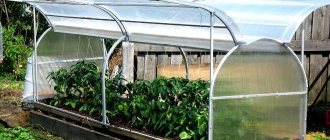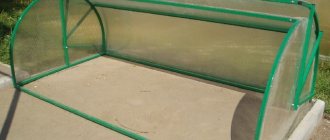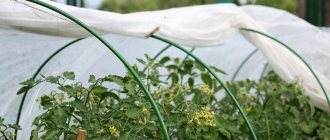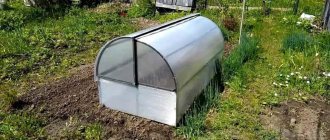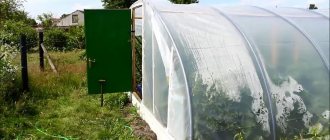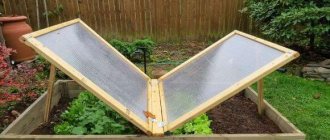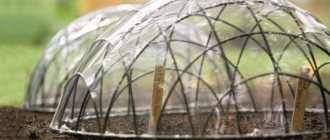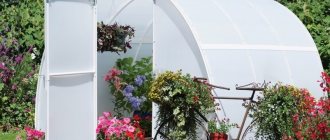- Polycarbonate greenhouses with opening top: features and purpose
- Polycarbonate greenhouse with opening roof: types and advantages
- How to choose a place to install a polycarbonate greenhouse
- How to install a polycarbonate greenhouse with your own hands: step-by-step instructions
- Choosing the right material to create a greenhouse frame
- How to make a foundation for a greenhouse with your own hands
- DIY polycarbonate greenhouse assembly: “Snail” model
- Additional tips for assembling a polycarbonate greenhouse “Snail”
- Features of assembling the greenhouse “Zucchini” video instructions and recommendations
- Video: assembly of the greenhouse “Zucchini”
- Belgian greenhouse: design description and installation features
- How to properly care for polycarbonate greenhouses and greenhouses
- How to choose and buy a polycarbonate greenhouse with an opening top
- Installing a polycarbonate greenhouse with your own hands: video instructions
- Video: clever greenhouses with opening roof
Early cultivation of crops always carries serious risks that external factors will become an obstacle, depriving the harvest and devaluing all the efforts made. Therefore, gardeners try to protect their plants from weather changes by providing them with the most comfortable conditions possible. One such way is to use polycarbonate greenhouses with an opening top. Let's look at the advantages of this design and how to make it yourself.
Thanks to the opening roof, it is easy to ventilate a polycarbonate greenhouse, thereby controlling optimal temperature and humidity levels.
Polycarbonate greenhouses with opening top: features and purpose
A greenhouse is an agricultural structure designed for growing seedlings or small plants in closed ground conditions. Due to the fact that the walls of the greenhouse are made of transparent material that does not prevent the penetration of sunlight, the soil inside heats up, and the moisture does not evaporate as it does in open ground. As a result, the most favorable conditions for plants are created inside: high and stable temperature, as well as humidity.
A compact, opening greenhouse for seedlings with a shelf for gardening supplies and fertilizers can be built independently without large financial investments.
On a note! If you want to provide comfortable conditions for plants, you can increase the level of CO2 in the greenhouse. To do this, it is enough to place it next to the place where any organic waste decomposes.
It is important not to confuse a greenhouse with a greenhouse, since these structures have serious differences from each other, and primarily this concerns their dimensions. Greenhouses are significantly larger in size than greenhouses and can be used for growing large crops. Greenhouses, as a rule, do not exceed human height in height and are used for seedlings or small plants.
The standard dimensions of a greenhouse do not exceed 1-1.5 m in length, 1-1.5 m in width if the structure is single-leaf and 2-3 m if it is double-leaf. The length of such a structure can be from 1.5 to 4 m, depending on the desires and capabilities of the owner.
Structures of this type are used for growing a variety of crops, including all kinds of greens: dill, parsley, lettuce, lettuce, sorrel; vegetables: carrots, onions and others. You can also grow berries, such as strawberries, strawberries. Greenhouses are often used for growing flowers.
Polycarbonate greenhouses with an opening top are ideal for growing small plants such as aromatic herbs, peppers or strawberries.
It is important to understand that placing plants inside a greenhouse is only one of the stages of growing them. In the future, you will have to constantly ensure that the conditions inside the structure are comfortable for the plants being grown. Do not allow overheating or freezing. It is for this purpose that opening doors are used, which allow you to regulate the temperature and prevent dehydration and death of plants.
Materials and tools
It is preferable to use cellular polycarbonate.
The material for a greenhouse is most often cellular polycarbonate . It is lighter than monolithic, transmits sunlight just as well and retains heat. Its mechanical strength is somewhat lower, but this parameter can be ignored when constructing greenhouses.
You need to choose a material that is transparent and colorless . Ordinary polycarbonate is not very resistant to ultraviolet radiation - it turns yellow over time and transmits light less well, so you need to choose a material with a protective film.
For the frame, a wooden beam or metal profile . The first is more convenient when constructing a Belgian structure and small greenhouses. For arched and large modules with a length of up to 4 m, it is better to take a metal profile with a cross-section of 20*20 mm. Aluminum is preferable, as it is lighter, corrosion resistant and much easier to bend.
Tools needed:
- grinder or hacksaw;
- drill or screwdriver;
- tape measure, metal scissors, building level;
- screwdrivers, wrench and profile bending tools.
Work should be carried out in protective clothing and gloves. If you need to do a lot of drilling or cutting metal, you need to use glasses.
Polycarbonate greenhouse with opening roof: types and advantages
Polycarbonate greenhouses with an opening top gained their popularity due to the ease of use of this design. But at the same time, you should not miss the fact that designs of this type may differ from each other and have their own characteristics and advantages. Among the main types, it is worth noting three options:
- The “Snail” greenhouse is a structure with a cross-section in the form of an arch. One or both doors of such a structure open, giving the owner access to the plants.
- The “Zucchini” greenhouse is another structure with an arched section. This one differs from the previous version in the way it opens: the doors rise upward, which is often associated with insect wings. Because of this, you can often find the second name for this greenhouse – “Butterfly”.
- “Belgian greenhouse” is not such a popular, but still quite well-known option among summer residents. Externally, a body of this design resembles a box or chest, the top lid of which rises. In this case, the upper part of the greenhouse can be single or gable.
The “Belgian greenhouse” from the manufacturer is equipped with a special holder for the lid.
According to greenhouse owners, each of these options has its own advantages and is worthy of being installed on the site. Let's consider the main positive aspects of using such structures:
- the dimensions of the greenhouses allow them to be installed in almost any, even very small area;
- low cost is another advantage of such greenhouses. All materials required for the manufacture of the structure are quite affordable, which makes it possible to purchase such a greenhouse or make it yourself;
- greenhouse designs are mobile. The owners have no problems dismantling the structure or simply moving it to another place, because the size and weight of a polycarbonate greenhouse are quite small;
- efficient use of the entire territory allocated for the greenhouse. Thanks to the opening roof, the owner can access any plant located inside the structure;
- There is no need to buy a ready-made greenhouse if you can devote a little time and effort. With minimal financial costs, it is quite possible to build a structure with your own hands, especially if you have a basic set of tools and the ability to handle them.
To make it convenient to open and fix the lid of a small greenhouse, you can use the old mechanism from the cabinet.
On a note! To buy the most convenient greenhouse, you can view as many design options as possible on the Internet. To do this, you need to enter an exact query in the search engine, indicating the city in which you live. For example, write down “Polycarbonate greenhouses with an opening top in Cherepovets.” In the photo section you can see all possible options and prices.
Types of greenhouses with a removable roof
Agree, a removable roof for a greenhouse is only needed when it can be easily removed. Because in a maximum of 10 minutes. So let’s take a closer look at the options offered by the market:
Design #1 – removable and liftable roof
These types of designs can be ordered today from private craftsmen:
The roof of the “Clever Nurse” moves with a slight turn of the handle - very simply. In addition, the design has two more windows and two doors. Moreover, the dome of the greenhouse opens differently in winter and summer, for which a special mechanism is installed. But not everyone appreciates the “Clever Nurse” due to the fact that its cellular polycarbonate is oriented horizontally in honeycombs, which is why it can darken over time. Although it is on this greenhouse that you can easily organize automatic roof removal.
The Slava-Lux greenhouse has a similar design:
Design #2 – greenhouse-convertible
The option with compartment windows is also interesting. In this know-how, the roof of the greenhouse is not removed entirely, but only moved to the sides. In the summer heat, such a mechanism is used as vents, and in winter it is a direct path for snow directly onto the beds. They simply collected the harvest, moved parts of the roof - and with peace of mind returned to the city until spring. There is no need to come here to dump the snow or throw it with shovels inside the greenhouse. Such a greenhouse can also be divided into two compartments, and each crop can have its own growing conditions, because the compartment roof consists of two parts.
Another design option with a removable roof is meter-long polycarbonate sheets that slide down. These are the “Matryoshka” and “Cabriolet” greenhouses. And this is what the “Cabriolet” greenhouse represents. Height 2 meters, two vents at the ends and two doors. There are trusses on the roof every meter, and each of them has a special profile with grooves attached. Polycarbonate is inserted into them, which can be moved down with a slight movement of the hand. But there is also a special clamp on the side, which is used when the roof is closed - so that it does not move out.
At Dachnaya-Zvezdochka, polycarbonate is inserted into special grooves. By pulling the special handle, you can lower or completely pull out the polycarbonate.
Design #3 – sliding pencil case
But the “Matryoshka” greenhouse with a removable roof opens like a pencil case - its entire parts are superimposed on one another. It looks quite impressive, but snow will not fall on all the beds in winter - the furthest ones at the ends will remain empty. But the roof won’t break, and this is an arched greenhouse. But there is no handle here anymore - you need to unscrew the nuts for manual screwing, lift each section and move it closer to the end. Ventilation in this way in the heat is also noticeable.
How to choose a place to install a polycarbonate greenhouse
Owners of summer cottages do not always have the question of where to locate the greenhouse. Indeed, in most cases, the area is initially small, so the structure is placed where it fits. But even in this case, it is worth taking care of its correct location. As for large areas where there is enough space for a greenhouse, here you need to try to meet all the necessary conditions, which will allow you to get a high yield in the future.
Regardless of the size of the plot, the greenhouse should be positioned so that it “looks” to the south or east. This will provide the plants with enough sunlight. As practice shows, in greenhouses located to the north or west, most crops grow worse.
Before building a greenhouse, it is worth considering its location so that the plants receive enough sunlight and heat.
In addition, it is important to ensure that the greenhouse is located in a well-lit area. Trees and walls of buildings should not interfere with sunlight, as this is extremely important for their growth and development. At the same time, it is worth providing the structure with protection from the north, since it is from this side that the coldest winds blow.
On a note! In addition to all objective factors, when choosing the location of a greenhouse, it is also important to take into account the ease of use. The most important thing is that you have free access to any point and can open the top without any problems.
What are the benefits of sliding structures?
In winter, the greenhouse itself fills with snow.
The advantages of a retractable greenhouse roof are obvious:
- They provide ideal conditions for plant growth and fruiting.
- The opening roof provides the necessary access to oxygen and ultraviolet radiation.
- In such greenhouses there is always a balanced microclimate.
- Natural soil moisture, ventilation and pollination.
- There is no need to specially bring snow into a greenhouse that is open for the winter - it falls there on its own.
- Saves time for the owners.
How to install a polycarbonate greenhouse with your own hands: step-by-step instructions
Looking through photos of polycarbonate greenhouses, you will notice that they all have a fairly simple design, the independent production of which does not require too much effort. But in order for the resulting structure to meet all the requirements and be durable, you need to try to follow some recommendations. Let's look at each step of construction step by step.
The finished polycarbonate greenhouse is easy to install, since the kit includes all the necessary fasteners, holders or assembly instructions.
Advantages of the structure
Despite its modest size and simple design, the advantages of the greenhouse are obvious:
- reasonable price;
- hinged lid;
- durability;
- ease of assembly;
- constant lighting;
- simple overheat protection system.
Thanks to the hinged lid, snow gets inside the greenhouse in winter. It is not much, but enough to prevent the earth from drying out and losing salt. A removable lid protects plants from overheating. It is much better than a window: since the window occupies a limited area, heating occurs unevenly.
Choosing the right material to create a greenhouse frame
You can make a greenhouse with an opening top from almost any material. However, this will largely determine its service life and affect how comfortable it will be to use and how often you will have to deal with the need for repair work. Let's look at the most common materials and their characteristics.
Wooden frames for greenhouses are not used very often, although it is worth recognizing that this particular material is used for this purpose most often than any other. Now they are gradually abandoning it, which is due to its two significant disadvantages: a tendency to rot and dry out. In addition, wood can be a habitat for insects.
A much more durable polycarbonate greenhouse will be obtained if you use a galvanized profile for the frame. This is a very durable material, so a structure made from a profile will not be affected by precipitation and strong winds. In addition, the material is easy to work with, allowing assembly even by one person.
When choosing a material for a greenhouse frame, you should take into account the required service life and the possibility of rearranging the finished structure.
To assemble the frame, you can also use galvanized corners. Thanks to this, the strength of the structure will be extremely high, however, the cost of the greenhouse will be slightly higher. It is precisely because of the extra expenses that summer residents do not use this material too often, especially when it comes to building a small greenhouse for seedlings or greenery.
Another, very convenient, but not so expensive option is metal-plastic pipes. They are very flexible, making them easy and convenient to work with, giving them the desired shape. The finished structure will be light in weight and, if necessary, can be easily moved to another location.
On a note! If you need to make a temporary structure, and at the same time you need to spend as little money as possible on it, then the ideal option would be to use plastic pipes and plastic film.
If you value reliability and durability, then you should pay attention to aluminum pipes. This is a rather expensive material, which, nevertheless, can last for many years. But such a structure should not be installed in an uncovered and unguarded area.
If wood is used in the construction of a greenhouse, it is worth taking care to coat such elements with a special wood paint for exterior use.
Roof repair
This place is the most vulnerable in the entire structure, being under direct influence of ultraviolet radiation and physical factors. Therefore, it requires special attention during periodic maintenance inspections and operation. Pay attention to the following factors:
- On metal frames - on the condition of the material. Damage on it manifests itself in the form of rust. They are opened and processed mechanically or chemically to pure metal. After this, the part is primed and painted again.
- On wooden frames - for cracks and rot. If the damage is deep, the part or part of it is cut out and replaced. To eliminate leaks in the roof, remove the glass, clean the surface, apply silicone sealant and put the glass back.
- A characteristic defect on a polycarbonate coating is the penetration of moisture and dust into the internal channels. As a result, the translucency of the structure decreases. This sheet is removed from the frame, then the channels are blown out with compressed air. If necessary, they are washed with soapy water. The cleaned sheet is dried and the ends are sealed with adhesive tape.
To protect polycarbonate from dust and moisture, its ends are sealed with special tape.
If mechanical damage is found on the outside of the coating, it is better to replace the material. The minimum service life of polycarbonate is about 8–10 years, and earlier failure indicates poor quality of the material or an installation error. Local damage to the polycarbonate coating is repaired in three ways:
- Using adhesive tape or electrical tape: degrease the surface and stick the tape, heat the edges with a hairdryer to improve the adhesion of the material.
- Liquid nails are used to seal small through holes or close openings at the end.
- Using rubber glue, apply a patch of thick film or polycarbonate trim to extensive damage in the coating.
When using plastic for the frame, there is no need to talk about repairs: the material is very strong and durable. Over time (after 10 years or more) it becomes fragile. In this case, a complete replacement of the frame is performed.
Damage and tears in the plastic film are repaired with tape to maintain the greenhouse until the end of the season. Annual replacement of such a shelter is inevitable. A frame that has sunk under the snow indicates errors in its development, including the wrong choice of material. It is better to revise the project taking into account the errors and make a new design.
Video: polycarbonate roof repair
How to make a foundation for a greenhouse with your own hands
The foundation is no less important part of the greenhouse than the frame or covering material. It acts as a support, as well as a heat-insulating layer, preventing the soil inside the structure from freezing. In addition, a favorable environment is maintained inside the greenhouse, which is formed due to the decomposition of organic residues.
Considering the fact that a polycarbonate greenhouse is lightweight, it is quite possible to do without a foundation. But if you do not plan to move the greenhouse, then it is better to take care of arranging a foundation made of brick, timber and concrete.
The simplest algorithm of actions is as follows:
- Markings are made along the perimeter of the future greenhouse.
- According to the markings, trenches 10-25 cm deep are dug.
- A third of the trench is filled with sand.
- Bricks or a box made of timber of a suitable size are laid inside.
- All remaining space in the trench is filled with gravel. Although it is quite acceptable to simply cover it with earth.
- The frame is fastened to the foundation using long metal pins, each of which is driven 50-70 cm into the ground. This method allows you to secure the greenhouse as effectively as possible and prevent it from moving even when exposed to very strong winds.
When constructing a foundation and box for a greenhouse, you can immediately arrange warm beds for plants, thereby providing fertilizing for vegetable crops.
Types of sliding mechanisms for greenhouse roofs
A greenhouse with a sliding roof has undoubted advantages over a stationary roof:
- Possibility of effective ventilation;
- No condensation on the internal walls due to air circulation.
This design will cost a little more, but these costs will be worth it after the first large harvest.
Typical options for greenhouses with a sliding roof include:
- Butterfly;
- Matryoshka;
- Cabriolet.
Butterfly
The advantages of this greenhouse roof design include:
- Efficient use of space and ease of working inside, even with the roof open;
- High strength and stability of the structure;
- Ease of ventilation;
- Ease of installation and economical consumption of materials.
For construction, a frame made of wooden beams and metal profiles is used.
For placement, a flat, well-ventilated place with good lighting is most often chosen. For cladding we can use both polycarbonate, polyethylene and glass. The height of such a structure is 1-1.5 meters, and if it is necessary to grow taller plants, it can be increased to the required size.
DIY polycarbonate greenhouse assembly: “Snail” model
This design allows for the possibility of opening one or two side flaps by sliding them up and back. This model is often called “Breadbox” due to a similar mechanism of action. The moving parts are attached using hinges, which ensure the possibility of their movement.
Most often, for the frame of a greenhouse with an opening roof of this type, a profiled pipe is used, which has a cross-section of 20x20 mm. Cellular polycarbonate with a thickness of 4 mm is ideal for cladding.
On a note! It is highly not recommended to use wooden beams to build a frame of this type. This material bends poorly, which significantly complicates the construction process.
In order for the final structure to be strong enough, in addition to the main frame elements, additional arcs must be installed, which are designed to strengthen the greenhouse.
In order for the coating to serve for a long time, polycarbonate should be attached to the greenhouse using special fasteners, profiles and plugs.
As an example, let's look at how to assemble a ready-made kit for a greenhouse, taking into account the fact that the procedure for constructing one yourself is not much different from standard assembly, with the exception of the need to carry out calculations and cut materials.
- All elements are unpacked and laid out on the ground. This also applies to polycarbonate sheets. In this case, it is necessary to determine which side the stabilizing coating is located on.
- One of the polycarbonate sheets is applied to the end part of the frame and secured with roofing screws or thermal washers. Moreover, the second option is preferable, since this will eliminate the risk of deformation and swelling of the coating in the event of exposure to high temperatures.
- Using a sharp construction knife, the polycarbonate is cut around the perimeter of the end. The same is done for the second end part of the structure.
- Then both ends are connected to horizontal elements, thus forming a single structure.
- The frame is assembled with the folding wall of the greenhouse and a polycarbonate sheet is placed on top. Using the same roofing screws, the polycarbonate is fixed to the frame. Next, you need to trim off all the excess with a construction knife.
- All that remains is to connect all the component parts together and check the serviceability of the movable mechanism, which is provided for comfortable opening of the sash.
Special corners are used to attach steel profiles, which ensure the reliability and durability of the entire greenhouse.
On a note! Be sure to use special plastic plugs to close the ends of the profile pipes. This way, you can prevent moisture from getting inside the frame. Also, to prevent corrosion, treat all fastening points with cold zinc.
The best purchased greenhouse projects “breadbox”
- “Breadbox” - made of cellular polycarbonate and galvanized profile (20x20 mm). Dimensions 2x1.2x0.8 m, the gap between the arcs is 1 m, the top has a double-sided opening. Price — 5440 rub. Assembly service – 2500 rub. The base is made of timber treated with an antiseptic – 2000 rubles.
- The snail (shell) is a convenient design with a hinged lid (one flap) made of a square profile pipe. Dimensions 2.1 x 1.1 x 0.75 m. Easy to assemble. Convenient transport sizes. Cost - 5700 rub. There are options with two doors.
A purchased greenhouse sometimes has additional features: legs that allow you to go deeper into the ground or borders that add protection to the plants.
Additional tips for assembling a polycarbonate greenhouse “Snail”
For comfortable use of a greenhouse, it is important to take care of the little things. For example, in order to lift the opening sash conveniently, you need to screw a handle to it. This can be done using small self-tapping screws.
It is also worth considering the possibility of fixing the lid in the open position. This will allow you to avoid dangerous situations when, as a result of a strong gust of wind, the sash closes spontaneously, which can injure the owner or render the polycarbonate unusable.
The “Snail” polycarbonate greenhouse model is one of the most popular solutions for growing tomatoes and cucumbers.
On a note! It is important to note that a greenhouse with a lid will not be completely sealed, since one way or another there will be a gap between the opening part and the main frame. This is not a problem, but on the contrary, natural ventilation, which will allow the plants to feel comfortable and also ensure the mobility of the sash.
Before you start using the greenhouse for its intended purpose, you need to take care of its internal arrangement. The ideal option is a system of warm beds, which you can make yourself. For this purpose, you need to prepare in advance a hole 50-60 cm deep under the greenhouse, which is filled with organic residues.
The remains are laid in stages, depending on the size: the largest are placed at the bottom, and the smaller ones on top. The topmost layer (about 15 cm) is fertile soil. All this is watered with microbiological fertilizers, which promote the decomposition process. Such beds will be full of nutrients and will have a positive effect on the growth of the planted plants.
Ready-made structures from the manufacturer can be equipped with special mechanisms for fixing the greenhouse lid.
Features of assembling the greenhouse “Zucchini” video instructions and recommendations
The “Shell” greenhouse, also known as “Zucchini”, differs from the previous model in the way it opens the moving flap. In this case, it does not move backwards, but upwards. This mechanism is similar to how the lid of a chest opens. In this case, if desired, you can make one or both doors open.
The selection of a site and preparation of the foundation in this case occurs according to the standard scheme. After this, you can proceed to assembling the frame itself. As in all other cases, you need to start assembling the structure from the ends. They are represented by two vertical posts, which are used to secure the structure to the foundation or ground.
Then, assembling a greenhouse with an opening top consists of connecting the elements of a hinged lid, which are connected to each other using special horizontal ties and welding. The lid is attached to the main frame using hinges. At the same stage, you need to take care of the presence of open position latches that will hold the sash in the open position.
The “Zucchini” greenhouse opens on both sides, which provides easy access to each planted plant.
After the structure has acquired a holistic appearance, all its connections must be tested for strength and treated with an anti-corrosion coating or paint, which will act as a protective layer.
Polycarbonate sheets are applied one by one to part of the frame, attached with self-tapping screws, after which all excess is removed.
On a note! In order to extend the life of the covering material, it is recommended to use sealing tape. With its help you can glue all the ends.
Each of the sashes must be equipped with a convenient handle for opening, and during the installation of the structure, you must use a building level to make sure that all supports are driven in evenly.
Reviews from gardeners
Most of them speak positively about such greenhouses in comparison with ordinary ones. Most often, the features already discussed in the “Advantages and Disadvantages” section are noted. The yield in such greenhouses is higher due to better ventilation and lighting - in a closed greenhouse it is not ideal even with a material such as polycarbonate. It is also important that ready-made greenhouses with a sliding roof differ little in cost from conventional ones. When you assemble it yourself, the materials are quite cheap.
But despite all the advantages, they are still relatively rare. The main reason is conservatism - many simply continue to use the same greenhouses as before, and are suspicious of new products. The difficulties that some gardeners have with sliding roofs and sides also play a role: when installed in the wrong place, the segments begin to jam, and some ready-made greenhouses are not strong enough, so their parts can be broken by the wind.
Gardeners note that for such a greenhouse to last a long time, you need:
- regularly lubricate the guides and clean the polycarbonate from accumulated dirt;
- wash it before and after use every season;
- after the second wash, treat with a disinfecting solution (for example, furacillin);
- if there is a lot of snow in the area, move the roof apart or remove it for the winter so that the roof does not collapse;
- Do not scrape the ice crust from the surface, otherwise the polycarbonate will be damaged;
- Every 3-4 years you need to replace the fertile layer, or at least add soil.
Belgian greenhouse: design description and installation features
The main difference between this model and those discussed earlier is the absence of any rounded elements. This greatly simplifies the assembly and installation process, and also provides more options for choosing materials. Both a profiled pipe and a wooden beam are suitable for this purpose. The instructions for these materials will be the same.
The work begins with carrying out calculations and determining the parameters of the future greenhouse. According to the drawing, cut the timber or profiled pipe into elements of the appropriate size.
A simple rectangular frame is assembled using corners and screws, if we are talking about a wooden base. For a metal pipe, you can use bolts and nuts, or you can simply weld all the elements together. In the same way, vertical posts are attached to the lower base. In order for the structure to be strong, additional rafters are installed between the racks.
An example of a simple greenhouse design with an opening lid made of wood and polycarbonate.
The greenhouse lid is assembled separately and attached to the frame using hinges. Here, as when assembling all other models, you need to make sure that the lid lock is in the open position.
Once the frame is completely ready, all that remains is to cut and secure the polycarbonate. To do this, you need to remove the packaging film from it and attach each of the sheets to one of the sides of the greenhouse. The material is secured with roofing screws and then cut to the required size.
The Belgian polycarbonate greenhouse is excellent for installation both on a foundation and in open ground. And provided that it is not too large in size, you can easily access any point of it, which will ensure comfortable work in the garden beds. And if you watch a thematic video before starting work, assembling a polycarbonate greenhouse will not pose any difficulties at all.
The Belgian greenhouse can rarely be found in garden centers or on specialized websites, but if necessary, it can be ordered from private manufacturers.
Differences between a “breadbox” and a “butterfly” greenhouse, which is better
Sometimes a “breadbox” is compared to a “butterfly”. They are similar, the main difference is that the doors of the latter open along a horizontal axis, resembling the wings of an insect. In addition, it is more difficult to assemble, it has more weight, and the sashes require supports when opening.
Greenhouse "butterfly"
The cost is higher - 6300-10982 rubles. There are various reviews about it, some of them are a terrible greenhouse, so the “butterfly” is less often installed on sites.
The “breadbox” model is easy to assemble and install, performs its functions well, and is not inferior in efficiency to similar greenhouses.
How to properly care for polycarbonate greenhouses and greenhouses
One of the main advantages of polycarbonate greenhouses is their long service life and the material’s resistance to external factors. But it is important to understand that the length of time a structure will serve you directly depends on how well you take care of it.
Proper care of a polycarbonate greenhouse includes a number of measures aimed at preparing the structure for the winter period. First of all, it is necessary to remove all remaining vegetation. If there are removable shelves or containers installed inside, they also need to be dismantled and taken out.
Considering the fact that the greenhouse has so-called “closed soil”, it must be treated, which will help prevent the development of pathogenic bacteria that can further harm the plants. To do this, the top layer is treated with special disinfectants or simply removed.
The main stage of preparing a greenhouse for winter is replacing or fertilizing the soil.
Each inner wall must be treated with a special soap-based solution. With its help, every seam and joint is processed, since it is in these places that microorganisms most often accumulate. Moreover, some insects can lay larvae there. To wash the walls you need to use a soft sponge or rag. Any harsh impact is unacceptable, as it may cause damage to the polycarbonate.
Note! It is not recommended to use chemically active solutions to clean the greenhouse, as they will negatively affect the characteristics of the covering material.
After the treatment, you need to let the walls dry naturally, after which the greenhouse will be ready for winter.
Site and foundation preparation
First, decide where on your summer cottage or garden plot the greenhouse with an opening roof will be located. In this case, one should take into account the direction of the winds, orientation to the cardinal directions and the presence of large objects nearby, such as houses, outbuildings, fences and trees.
Choosing a location for a greenhouse
So, it is desirable that the greenhouse be located in a place protected from the north wind and air currents caused by the “wind tunnel” effect. To fulfill this condition, there must be sufficiently large objects at some distance from the greenhouse that will “cover” the structure from the wind.
But it is worth understanding that “at some distance” does not mean “nearby”. Otherwise, a shading problem arises when a tree or house blocks the sun from entering the greenhouse. And, consequently, the growth rate and yield fall. Therefore, it is advisable that no large objects are located in front of the greenhouse on the south side, and only at a distance of at least 3-5 m on other sides.
Geographical direction of installation of a polycarbonate greenhouse
Important! As for the cardinal directions, the orientation of the structure depends on the latitudes in which it is being built. In northern regions, place the greenhouse with the long side facing south, and in low latitudes, orient it to the east.
After identifying the area for the greenhouse, mark it using pegs and rope. Clear the designated area of debris, rocks, fallen branches and tall vegetation. If there is a significant slope, level it or build a terrace. Then you need to build the foundation. Since greenhouses with an opening roof are in most cases lightweight buildings designed for use only during the summer season, there is no need for an expensive and complex structure. In this case, it is enough to build a foundation made of timber or brick.
Step 1. Measure out the required amount of material.
Beam for foundation
Important! Don’t forget, wood definitely needs to be treated with an antiseptic. And the best option from the point of view of durability would be to choose larch lumber.
Step 2. Dig a trench under half the height of the timber or brick. If the soil is hard enough, you can skip this step.
Step 3. If timber is chosen as the material for the foundation, put together a rectangular box from it to the size of the greenhouse, using reinforced corners and wood screws as fasteners.
Connecting foundation elements with a reinforced angle
Step 4. Lay the timber box or brick blocks on the prepared area. Align them horizontally using a building level. For additional waterproofing, the foundation can be covered on top with a layer of roofing felt.
Checking the foundation using a level
Video - “Umnitsa” greenhouses with opening roof
Greenhouse "Kremlevskaya Lux"
The Kremlevskaya Lux greenhouse is perhaps the most durable arch-type structure on the greenhouse market. It can easily cope with a significant snow load - it is not even afraid of the impact of 240 kg/m2, and these are quite large figures.
How to choose and buy a polycarbonate greenhouse with an opening top
Looking through photos of polycarbonate greenhouses, many wonder how to make the right choice and which option to give preference to. In fact, all the options considered are easy to use and at the same time look quite aesthetically pleasing. Therefore, one of the main criteria that should be followed is the cost of the structure and materials for its construction.
When purchasing a greenhouse, you should pay attention to the quality and reliability of small parts, since they are the first to fail.
Let's consider the approximate cost of several structures of different types and sizes:
- Provided that high-quality material is used for manufacturing, a “Snail” greenhouse 2 m long will cost an average of 4-6 thousand rubles. Of course, you can find options both more expensive and cheaper, but here it is important to understand that quality directly determines the cost, and therefore you should not purchase a frame that is too cheap. Using soft or thin metal will reduce its cost, but the slightest load will lead to deformation and malfunction of the opening system.
- As another, larger-scale example, consider a “Zucchini” design, which is twice the size of the previous version. Its cost will be about 5-7 thousand rubles. At the same time, you should pay attention to the fact that the frame you purchase has a sufficient number of additional stiffening ribs that will not allow such a long greenhouse to sag and deform under a layer of snow.
- Looking through a photo of a do-it-yourself greenhouse of the “Belgian” type, you can be convinced that this design is simpler in structure than all the others. In addition, it is worth noting that large manufacturers do not often undertake the production of greenhouses of this type, so if you need to purchase a ready-made frame, most likely you will have to order it from a small entrepreneur and pay the price that he specifies.
It is important to understand that when talking about the cost of a greenhouse, this price does not include the cost of covering material. That is, polycarbonate will have to be purchased separately, and you need to count on this when planning your construction budget.
Polycarbonate is a reliable and durable coating that perfectly transmits sunlight, which has a beneficial effect on the growth and quality of crops.
Characteristics and dimensions of the “breadbox” greenhouse
The “bread box” does not have strict dimensions - we select it so that it is convenient to open the doors.
Classic:
- length - 2 m minimum, 4 m maximum, otherwise mechanisms will be required to lift the roof;
- height - 0.5-1.3 m, we select it according to your height: if it is low, it will be inconvenient to maintain, if it is high, the weight of the structure becomes greater;
- the width is such that it is convenient to reach the opposite side: 1.3 m - one leaf, 2 m - two.
The shape is an arched frame, most often made from a profile pipe. Polycarbonate is usually used for covering. It is stronger than film and bends well, protects from ultraviolet rays, and retains heat better. Service life - 10 seasons. Film is used less often, because it is more difficult to secure and needs to be replaced every 1-2 years. The center of the turning line of the valves is located on the lower base or at the end of the vertical column (in the middle).
Installing a polycarbonate greenhouse with your own hands: video instructions
Each of the installation options that have been considered is a simple and at the same time effective way to make a polycarbonate greenhouse with an opening top, suitable for growing seedlings and small crops. Of course, there are no problems with purchasing a ready-made structure, but many summer residents still prefer home-made structures, believing that only on their own can they create an ideal polycarbonate greenhouse. Videos of installing the frame and covering the greenhouse with covering material clearly confirm that all stages can be completed with your own hands.
